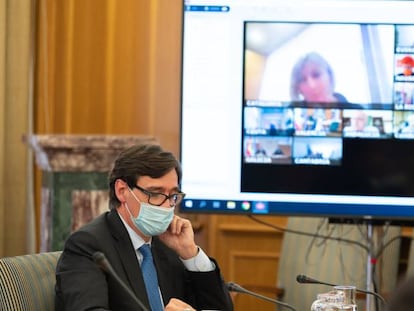Coronavirus incidence rate falls across Spain, but remains at ‘very high’ levels
The latest Health Ministry report recorded 12,289 new cases and added 337 deaths to the official toll
The incidence rate of the coronavirus continues to fall across Spain. The latest Health Ministry report, released on Thursday, recorded 12,289 new cases and added 337 deaths to the official toll. According to the report, the 14-day cumulative number of cases per 100,000 inhabitants now stands at 325. As this rate has dropped, the pressure on Spain’s hospitals has also eased, with the occupancy rate of coronavirus patients slowly falling.
Despite this improvement, all key indicators continue to be “very high,” warned Fernando Simón, the director of the Health Ministry’s Coordination Center for Health Alerts (CCAES) at a government press conference on Thursday. “This is not where we want to be,” he said, explaining that Spain was still far from reaching the goal of 25 cases per 100,000 inhabitants, a threshold that health authorities consider as having the epidemic under control.
The coronavirus incidence rate has fallen in all of Spain’s 17 regions, with the exception of the Canary Islands, where the figure has been stable for weeks, with slight fluctuations. The 14-day cumulative number of cases per 100,000 inhabitants in the archipelago stands at 77.6, the lowest rate in Spain.
The situation is not one of calm. It is important for both individuals and institutions to keep up the pressure and maintain the measuresFernando Simón, director of the Health Ministry’s Coordination Center for Health Alerts
Simón said that the incidence rate is not only falling across Spain, it is also falling among seniors over the age of 65, the collective most vulnerable to Covid-19. “But the situation is not one of calm. It is important for both individuals and institutions to keep up the pressure and maintain the measures,” he added, in reference to the restrictions aimed at curbing the spread of the virus.
Simón explained that there is a clear downward trend, but that this could be upset by the upcoming long weekend and Christmas holiday period. December 8 is a national holiday in Spain, while December 7 is a holiday in all regions except Cantabria, Castilla-La Mancha, Catalonia, Valencia, Galicia and the Basque Country. Under normal circumstances, this would be a time when many Spaniards take a holiday and travel, for example, to second residences in other parts of the country. “Let’s see how we behave,” said Simón. “It will have some effect, but we hope it will be as little as possible.”
On what restrictions will be in place over the Christmas holiday period, Simón said that it will be up to the regions to decide what measures to introduce, adding that these should be adapted to the epidemiological situation the regions find themselves in at the time. The health expert said that he was not completely opposed to the idea of testing everyone who returns home over the festive season, but explained that the Health Ministry’s policy was to carry out “targeted” testing, “not to do them in cases where they make no sense.” Simón said that the usefulness of PCR and antigen tests depended on the context, meaning it was important to be “careful” with large-scale testing. Antigen tests, for example, are not recommended in mass testing campaigns.
English version by Melissa Kitson.
Tu suscripción se está usando en otro dispositivo
¿Quieres añadir otro usuario a tu suscripción?
Si continúas leyendo en este dispositivo, no se podrá leer en el otro.
FlechaTu suscripción se está usando en otro dispositivo y solo puedes acceder a EL PAÍS desde un dispositivo a la vez.
Si quieres compartir tu cuenta, cambia tu suscripción a la modalidad Premium, así podrás añadir otro usuario. Cada uno accederá con su propia cuenta de email, lo que os permitirá personalizar vuestra experiencia en EL PAÍS.
¿Tienes una suscripción de empresa? Accede aquí para contratar más cuentas.
En el caso de no saber quién está usando tu cuenta, te recomendamos cambiar tu contraseña aquí.
Si decides continuar compartiendo tu cuenta, este mensaje se mostrará en tu dispositivo y en el de la otra persona que está usando tu cuenta de forma indefinida, afectando a tu experiencia de lectura. Puedes consultar aquí los términos y condiciones de la suscripción digital.
More information
Últimas noticias
Welcome to the post-religion era: The idea of Christianity as the absolute truth has become obsolete
‘I thought you would like it’: The risky sexual practice popularized by TV shows and TikTok
The digitalization of tourism: ‘They promise experiences and gave us the worst possible one’
Mexican peso defies uncertainty with forecasts of a new period of stability in 2026
Most viewed
- Sinaloa Cartel war is taking its toll on Los Chapitos
- Reinhard Genzel, Nobel laureate in physics: ‘One-minute videos will never give you the truth’
- Oona Chaplin: ‘I told James Cameron that I was living in a treehouse and starting a permaculture project with a friend’
- Why the price of coffee has skyrocketed: from Brazilian plantations to specialty coffee houses
- Silver prices are going crazy: This is what’s fueling the rally











































